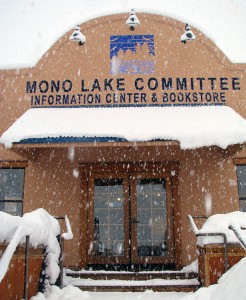

The severe drought conditions that persisted through most of January eased a little more in February. At the end of January, Lee Vining precipitation for the water year was 37% of average. But February precipitation was 76% of average in Lee Vining (and 70% of average at Cain Ranch), which raised the water year total-to-date since October 1st to 47% of average.
March 1st snow surveys, conducted between February 25th and March 3rd, found 49% of average snow water content in the Mono Basin. This is a big improvement—almost double the February 1st surveys. As with the February surveys, the Rush Creek drainage was surveyed before end-of-month storms, and the Lee Vining Creek drainage was surveyed after the storms. This makes the Rush Creek numbers look bleak (21–22% of average April 1st water content), compared to the Lee Vining Creek results (51–58% of April 1st water content). Most nearby watersheds were surveyed before the storms as well, and have much lower totals than the Mono Basin. Hopefully on April 1st we will get a more accurate picture.
Mono Lake rose 0.3 feet between January 1st and March 1st to 6380.69 feet above sea level, and will likely rise another tenth of a foot by April 1st. While no cutback in water export to Los Angeles is anticipated this year, on April 1st, 2015, Mono Lake could be very close to the 6380.0 elevation below which export is reduced from 16,000 acre-feet per year to 4,500 acre-feet per year. Regardless of which side of the trigger Mono Lake is on next year, throughout this runoff year (April 1, 2014-March 31, 2015) Mono Lake will be dropping to levels 40 feet below its natural level that could create additional problems for the nesting California Gulls and increase the severity of the dust storms coming off the exposed lakebed.
The impact of the drought on Grant Lake Reservoir is just beginning to be felt. December unimpaired runoff in Rush Creek above Grant Lake Reservoir was 7 cubic feet per second (cfs), and in January it was only 4 cfs (average is 23 cfs and 21 cfs, respectively). Yet Southern California Edison (SCE) released enough water out of Gem Lake Reservoir to maintain near-average dry year inflows to Grant Lake Reservoir, keeping its level steady through February. With Gem Lake Reservoir approaching its near-empty annual low point, on March 1st SCE dramatically reduced the flow from it through the Rush Creek Power Plant. This roughly halved the inflow from Rush Creek, and will cause Grant Lake Reservoir to begin dropping. But if it keeps snowing, and conditions stay the same or better, it might not drop for long, and we could see a repeat of last year’s runoff conditions and relatively stable Grant Lake Reservoir levels.
After predicting below-average conditions for months, the one-month precipitation outlook from the Climate Prediction Center is finally showing equal chances of above or below average precipitation! If March precipitation is any better than 50% of average, conditions will continue to improve. While the drought outlook for 2014 is still severe, and Mono Lake will keep dropping, the expected runoff looks less likely to be record-setting.
